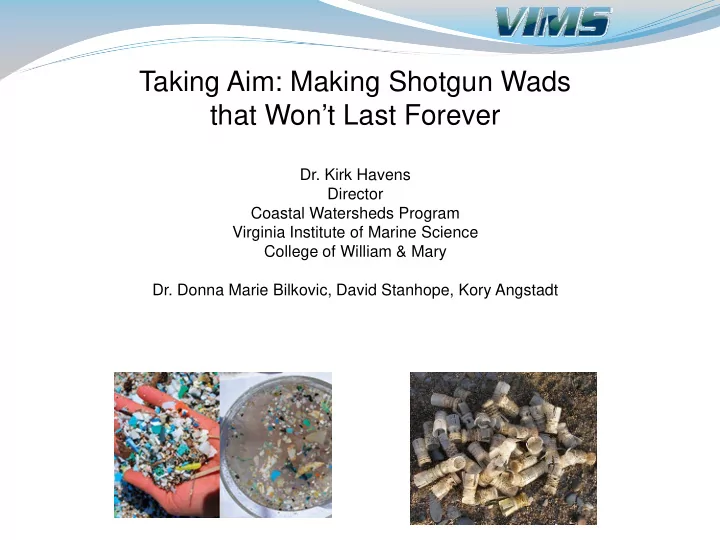

Taking Aim: Making Shotgun Wads that Won’t Last Forever Dr. Kirk Havens Director Coastal Watersheds Program Virginia Institute of Marine Science College of William & Mary Dr. Donna Marie Bilkovic, David Stanhope, Kory Angstadt
Plastic and microplastic Approximately 288 million tons of plastic is produced annually. Plastic has been found in the deep sea and buried in Artic ice.
About 8 million tons ends up dumped in the ocean every year. (about 5 plastic bags per foot per global shoreline)
Plastic shotgun wads An estimated 10-15 billion plastic shotgun wads are produced annually.
Smithsonian Institute
Fragmentation, photo-degradation, degradation Microplastics biodegradation (CO 2 , water, biomass)
This is a problem because…. Tube worms Shore birds Blue Crab Microplastics Mussels Zooplankton Microplastics: • can adsorb chemicals that are in the water • release previously bound-up chemicals into Turtle Striped Bass the water as they breakdown • readily take up PCBs and DDTs can introduces toxins into the food chain • • create obstructions that keep the organisms from taking in enough food, leading to malnutrition or starvation
Photo by J. McClain VIMS has developed a biodegradable shotgun wad from the polyhydroxyalkanoate (PHA) polymer
American Lobster Stone Crab Spiny Lobster www.mobjackbp.org
What is PHA? • PHA meets the American Society of Testing and Materials certification as biodegradable in aquatic environments. • European Standards and Vincotte International certification for biodegradation. • The US Food and Drug Administration standards for use in food contact, housewares, cosmetics, and medical packaging. • Medical applications such as sutures and drug delivery (pills).
Bureikan (2012 )
Shotguns are becoming the preferred weapon both commercially and by the military The military is also interested in a truly biodegradable wad
D egradable I nternal C asing wad ______________________________ D egradable U nderwater C asing wad DUCwad
Questions?
Recommend
More recommend